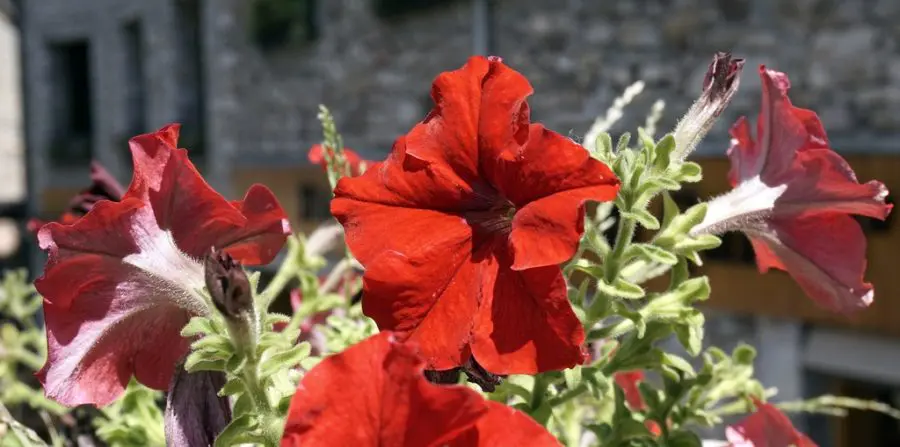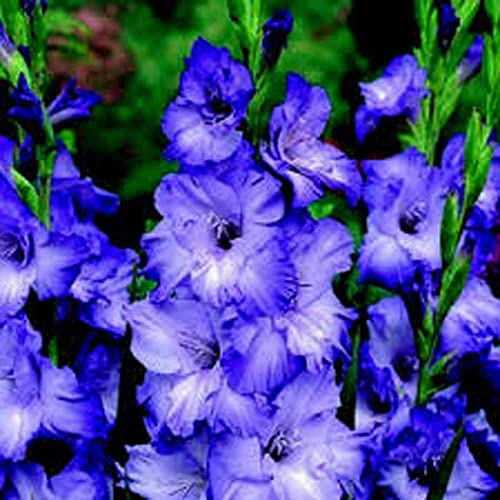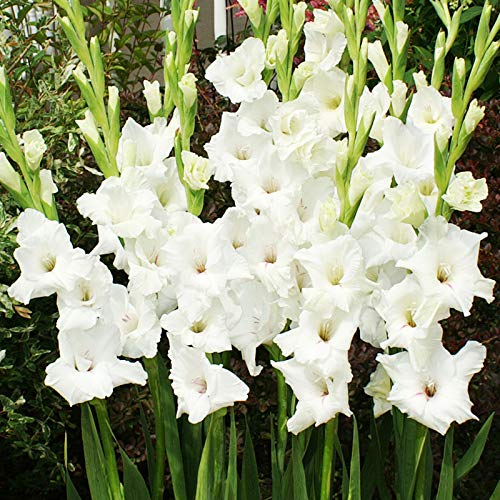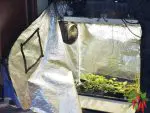This post contains affiliate links. If you buy something from one of our links we may earn a commission. Thanks

Can you grow Gladiolus indoors? Absolutely! Discover how easy it is to grow beautiful Gladiolus blooms indoors! Learn how to grow Gladiolus bulbs in pots.
You can grow Gladiolus indoors by planting corms in a deep pot with well-draining soil. Place the pot in a sunny location and water regularly, but avoid overwatering. Use a balanced liquid fertilizer every two weeks during the growing season. Ensure a stake is in place for the tall spikes to avoid them falling over.
Learn how to start Gladiolus bulbs in pots, their light and water requirements, soil preferences, and how to solve common problems.
Welcome to our gardening guide where we’ll answer the question that every Gladiolus lover has asked: “Can you grow Gladiolus indoors?”
The good news is that the answer is yes! With the right care and conditions, you can enjoy the beautiful blooms of these sword lilies right in your home.
Whether you’re looking to add some color to your indoor space or want to jumpstart the growing season, growing Gladiolus indoors is a great option.
In this guide, we’ll show you everything you need to know to get started on your indoor Gladiolus journey.
Can You Grow Gladiolus Indoors?
Hey there, gardening enthusiasts! Are you wondering if you can grow Gladiolus indoors? Well, the short answer is YES!
Gladiolus are not only gorgeous outdoor plants, but they can also thrive indoors under the right conditions.
Whether you’re a seasoned plant grower or just starting your gardening journey, growing Gladiolus indoors can be a fun and rewarding experience.
In this post, we’ll walk you through everything you need to know to successfully grow Gladiolus indoors, from lighting and watering requirements to soil and potting tips.
So, let’s get started!
Explanation of Gladiolus
Gladiolus, also known as sword lilies, are flowering plants that produce tall, colorful blooms.
They are native to South Africa and have been popular among gardeners for generations.
Gladiolus plants have narrow, sword-like leaves and tall flower stalks that can grow up to 4 feet tall, while only spreading about 1 foot wide.
They are considered tender bulbs and typically require a growing season of at least 90 to 100 days.
Overview of growing Gladiolus indoors
Growing Gladiolus indoors is a great way to enjoy these beautiful blooms year-round.
Gladiolus bulbs or corms can be planted in pots filled with well-drained soil like coco coir, or other well-drained growing media.
They require full sun and consistent moisture, with good drainage and good air circulation.
Gladiolus bulbs can be planted in late winter or early spring to jump-start the growing process, or in early summer to enjoy blooms in the following year.
They can also be started indoors and later transplanted outdoors.
Benefits of growing Gladiolus indoors
Growing Gladiolus indoors in pots offers several benefits, including having beautiful blooms year-round, avoiding pests and diseases that outdoor plants are exposed to, and having better control over the growing conditions.
Indoor Gladiolus plants also offer the opportunity to continually harvest flower spikes for cut-flower displays, which can be a great way to add color and life to any room in your home.
Plus, the process of growing Gladiolus indoors can be a fun and rewarding experience for any gardener, regardless of their level of experience.
Gladiolus Indoor Benefits-Why Grow In Pots?
Growing Gladiolus indoors can bring a lot of joy and satisfaction to any plant enthusiast.
Not only does it allow you to enjoy the beauty of these stunning flowers from the comfort of your own home, but it also provides several benefits.
In this section, we’ll delve deeper into the advantages of growing Gladiolus indoors, so keep reading to discover why it’s worth giving this indoor gardening adventure a try!
Aesthetic value:
One of the greatest benefits of growing Gladiolus indoors is the stunning aesthetic value they bring to any space.
These flowers come in a wide range of colors, from soft pastels to bold and vibrant hues, making them a versatile addition to any interior décor.
Whether you choose to display them in a sunny window or a shady corner, Gladiolus blooms add a pop of color and liveliness to any room.
Control of growing conditions:
When you grow Gladiolus indoors, you have complete control over their growing conditions.
You can ensure they get the right amount of light, water, and nutrients, as well as protect them from harsh weather conditions that could harm the plants.
This control allows you to provide the best possible growing conditions for your Gladiolus plants, resulting in healthier, more vibrant blooms.
Continual harvest of flower spikes:
Unlike outdoor Gladiolus plants that typically bloom all at once and then go dormant, growing Gladiolus indoors allows for a continual harvest of flower spikes.
By staggering the planting of your Gladiolus bulbs, you can ensure that you have a steady stream of beautiful blooms throughout the growing season, rather than a one-time burst of color.
Protection from outdoor pests and disease:
When growing Gladiolus indoors, you can protect them from outdoor pests and diseases that can quickly spread and damage your plants.
By keeping your plants indoors, you can minimize the risk of infestation and disease, allowing your Gladiolus to grow and bloom with minimal intervention.
Plant Size
Gladiolus plants are known for their tall and impressive flower spikes that can reach up to 4 feet in height.
However, this size can be both a blessing and a curse when it comes to indoor growing.
On the one hand, tall Gladiolus flower spikes can add an impressive vertical element to your indoor garden.
On the other hand, they can quickly outgrow their pots and become unmanageable.
In this section, we’ll take a closer look at the plant size of Gladiolus and how to manage it when growing indoors.
Gladiolus plant height and width:
When it comes to Gladiolus plants, it’s important to remember that they can grow quite tall.
Typically, Gladiolus flower stalks can grow anywhere from 2 to 4 feet tall while only spreading about 1 foot wide.
This means that they can easily become top-heavy and unstable if not grown in the right pot size or with proper support.
Choose a terracotta or ceramic pot to avoid tipping but make sure they have drainage holes.
Choosing the right pot size:
When it comes to growing Gladiolus indoors, choosing the right pot size is crucial.
You want to select a pot that is large enough to accommodate the gladioli corms and has good drainage.
The ideal pot size is at least 8-10 inches in diameter and 12-14 inches deep, which will provide ample space for the roots to grow and prevent the plant from becoming top-heavy.
Spacing and arrangement of Gladiolus pots:
The spacing and arrangement of Gladiolus pots are also important.
Bury each bulb root side down and 4-6 inches deep and 2-4 inches apart. You may need to add a stake for taller varieties.
You want to make sure that each pot has enough room to grow and that they are not crowded together.
It’s recommended to space pots about 12-18 inches apart to allow for good air circulation and prevent the spread of disease.
Additionally, you can arrange the pots in a row or stagger them to create a visually pleasing display.
Light Requirements
When it comes to growing Gladiolus indoors, lighting is one of the most important factors to consider.
Gladiolus plants require plenty of light to grow healthy and strong, and providing the right amount of light is essential for a successful indoor garden.
In this section, we will explore the specific light requirements of Gladiolus plants, and provide tips and tricks for ensuring that your indoor Gladiolus garden gets the light it needs to thrive.
Hours of sunlight needed
Gladiolus plants require plenty of light to thrive and produce beautiful blooms.
Ideally, they need at least 6-8 hours of direct sunlight every day.
Placement near a sunny window
Placing your Gladiolus pots near a south-facing window is a great way to ensure they get enough sunlight.
If you don’t have a south-facing window, you can also consider placing them near a west or east-facing window.
Use of artificial lights
If you don’t have access to natural light or your windows don’t provide enough sunlight, you can also use artificial lights to supplement the light requirements for your Gladiolus plants.
LED grow lights are a great option that can provide your plants with the necessary spectrum of light for optimal growth.
Just be sure to keep the lights on for 10-12 hours a day and adjust the height of the lights according to the manufacturer’s instructions as the plants grow to prevent them from burning.
Watering Requirements
Watering is an essential aspect of growing any plant, and Gladiolus is no exception.
If you’re thinking of growing Gladiolus indoors, it’s crucial to understand their watering requirements to ensure they thrive.
In this section, we’ll discuss how much and how often you should water your Gladiolus plants, as well as the importance of maintaining consistent moisture levels.
So, grab your watering can, and let’s dive into the watering requirements of Gladiolus.
Importance of Good Drainage
One of the most important factors in growing healthy Gladiolus plants is ensuring they have good drainage.
Without proper drainage, Gladiolus bulbs can easily rot, leading to stunted growth or death.
When growing Gladiolus indoors, make sure the pots have drainage holes and use a well-draining soil mix.
Adding perlite or sand to the soil can also improve drainage.
Watering Frequency and Amount
Gladiolus plants require consistent moisture, but not too much water.
As a general rule, water the plants deeply once a week, allowing excess water to drain out of the bottom of the pot.
Avoid letting the soil dry out completely, as this can cause the bulbs to become dehydrated and stunt growth.
On the other hand, overwatering can lead to rot and other fungal diseases.
Signs of Overwatering and Underwatering
It’s important to monitor the moisture level of your Gladiolus plants regularly.
Signs of overwatering include yellowing or wilting leaves, mold or fungus growth, and a sour or musty odor coming from the soil.
Signs of underwatering include dry, brown leaves and a general lack of growth.
If you notice any of these signs, adjust your watering schedule accordingly.
Gladiolus Soil
If you’re planning to grow Gladiolus indoors, the soil you choose can play a crucial role in their overall health and growth.
In this section, we’ll be discussing the importance of soil and how to choose the right type of soil for your Gladiolus.
A healthy soil mix that provides proper aeration and drainage is essential to support healthy root growth and prevent problems like root rot.
Let’s dive in and learn more about the best soil options for growing Gladiolus indoors.
Benefits of Coco Coir as a Growing Medium:
When it comes to growing Gladiolus, the right soil is essential.
Coco coir is a great option for those looking to grow Gladiolus indoors because of its excellent drainage and water retention properties.
Made from the outer husk of coconuts, coco coir is a sustainable and environmentally friendly alternative to traditional soil.
It also provides a high amount of oxygen to the roots, allowing the Gladiolus to thrive.
Preparation and Use of Coco Coir:
Preparing coco coir for use as a growing medium is relatively easy.
Simply soak the compressed bricks in water for at least 30 minutes until they have fully expanded.
Then, fluff the coir with a fork or your hands to break up any clumps.
You can then mix it with other perlite or use it as a standalone growing medium for your Gladiolus.
Other Soil Options for Growing Gladiolus:
While coco coir is an excellent choice for growing Gladiolus indoors, it is not the only option.
A well-draining potting soil mix with plenty of organic matter and good aeration will also work.
Just be sure to avoid heavy soils that do not drain well, as they can lead to root rot and other problems.
Additionally, adding perlite or vermiculite to your soil mix can help with drainage and aeration.
VII. Gladiolus Pots
Have you been considering growing Gladiolus indoors but wondering what kind of pots to use? Look no further!
In this section, we’ll discuss the different types of pots that work well for growing Gladiolus indoors and the benefits of each.
Choosing the right pot is an important aspect of successfully growing Gladiolus indoors, and we’re here to help you make the best choice.
So, let’s dive in and explore the world of Gladiolus pots.
Types of Pots for Growing Gladiolus Indoors
When it comes to choosing a pot for growing Gladiolus indoors, there are a few options to consider.
Terra cotta, plastic, and ceramic pots are all popular choices, but it’s important to select the right type of pot for your specific needs.
You may also want to consider the size of your Gladiolus plant and its root system, as well as the overall aesthetic you’re going for.
Choosing the Right Pot Material
Choosing the right material for your Gladiolus pot is just as important as selecting the right type of pot.
Terra cotta is a popular choice for its porousness, which allows for better air circulation and drainage.
Plastic pots, on the other hand, are lightweight and won’t break easily, but they don’t provide as much insulation as terra cotta.
They are also more likely to tip with a tall plant.
Ceramic pots can be a great choice if you want something with a little more style, but they can be heavy and can be prone to cracking if not handled with care.
Pot Drainage and Drainage Holes
No matter what type of pot you choose, it’s essential to ensure that it has proper drainage.
Without adequate drainage, your Gladiolus plant can become waterlogged, leading to root rot and other problems.
When selecting a pot, look for one with drainage holes in the bottom.
You can also create additional drainage by adding rocks or gravel to the bottom of the pot.
Gladiolus Fertilizer
One of the keys to successfully growing Gladiolus indoors is providing them with the right nutrients.
While a well-draining soil mix and proper watering are important, it’s also important to fertilize your Gladiolus plants regularly.
Fertilizer provides essential nutrients for the plants to grow healthy and strong, which can result in more robust blooms.
In this section, we’ll discuss the different types of fertilizer you can use for your Gladiolus plants, how often to fertilize and other tips for keeping your plants healthy.
The Importance of Fertilizing Gladiolus Plants
Fertilizing is an important aspect of growing healthy and beautiful Gladiolus plants indoors.
Gladiolus plants require essential nutrients for growth, including nitrogen, phosphorus, and potassium.
Fertilizer provides these nutrients to the plants, enabling them to produce vibrant and robust blooms.
Without proper fertilization, your Gladiolus plants may not grow to their full potential and may produce fewer blooms.
Types of Fertilizers for Gladiolus Plants
There are different types of fertilizers that you can use to feed your Gladiolus plants.
You can use organic or synthetic fertilizers, depending on your preference.
Organic fertilizers are made from natural materials such as bone meal, fish emulsion, and compost.
They release nutrients slowly over time and improve the soil structure.
Synthetic fertilizers, on the other hand, are made from chemicals and release nutrients quickly.
They are convenient and easy to apply, but they can also harm the environment if used improperly.
Fertilizer Application Frequency and Amount
To ensure the healthy growth and blooming of your Gladiolus plants, you need to apply fertilizer at the right frequency and amount.
You can apply fertilizer to your Gladiolus plants every two to three weeks during the growing season.
The amount of fertilizer to apply depends on the type of fertilizer you use and the size of your pot.
Follow the instructions on the fertilizer package for the correct application rate.
Avoid over-fertilizing your plants as this can lead to burned foliage and stunted growth.
Temperature and humidity
 Temperature and humidity play crucial roles in the successful growth of Gladiolus.
Temperature and humidity play crucial roles in the successful growth of Gladiolus.
Understanding the ideal conditions for these beautiful plants will help you provide them with a thriving environment.
In this section, we’ll explore the temperature range for growing Gladiolus indoors, the importance of maintaining appropriate humidity levels, and tips to create a favorable climate for your Gladiolus plants.
Ideal Temperature Range for Growing Gladiolus Indoors:
Gladiolus plants thrive in daytime temperatures between 70 to 85°F (21 to 29°C) and nighttime temperatures between 60 to 65°F (16 to 18°C).
These temperatures mimic the warm climate they prefer, providing them with optimal conditions for growth and blooming.
It’s important to ensure that the indoor environment where your Gladiolus plants are located falls within this temperature range to promote healthy development.
Maintaining Proper Humidity Levels:
While Gladiolus plants can tolerate a wide range of humidity levels, it’s generally best to maintain moderate humidity between 40% and 60%.
This ensures the air isn’t too dry, which can lead to issues such as dry foliage and hinder plant growth.
You can increase humidity levels around your Gladiolus plants by using a humidifier, placing a tray of water near them, or grouping them together to create a microclimate of higher humidity.
Tips for Creating a Favorable Climate:
To provide the best possible environment for your Gladiolus plants, consider these tips:
• Place the pots in a location where they can receive adequate air circulation without being subjected to direct drafts or cold air.
• During hot summer days, provide some shade or move the plants to a slightly cooler spot to prevent stress from excessive heat.
• Monitor the temperature and humidity levels regularly using a thermometer and hygrometer to ensure they remain within the recommended range.
• Adjust temperature and humidity levels accordingly based on the specific needs of your Gladiolus plants and the conditions in your home.
By maintaining the ideal temperature range and ensuring appropriate humidity levels, you can create a comfortable and conducive environment for your Gladiolus plants to thrive and showcase their stunning blooms.
Maintenance
Now that you’ve planted your Gladiolus bulbs and they’ve started to grow, it’s important to take proper care of them.
Gladiolus plants require a bit of maintenance to ensure they continue to grow healthy and produce beautiful blooms.
But don’t worry, taking care of your Gladiolus plants is easy and straightforward.
With a little bit of effort, you’ll be rewarded with stunning flowers in no time.
In this section, we’ll cover everything you need to know about maintaining your indoor Gladiolus plants.
Pruning Gladiolus Plants:
Pruning is an essential part of growing healthy Gladiolus plants indoors.
It involves removing dead or damaged leaves, spent flowers, and trimming the stem tips to promote lateral branching.
Regular pruning not only keeps your plant healthy and tidy but also helps in the development of new flower spikes.
It’s crucial to use clean and sharp pruning shears to avoid damaging the plant.
Deadheading Spent Flowers:
Deadheading is the process of removing flowers that have already bloomed and started to fade.
This process prevents the plant from using energy to produce seeds and redirects that energy toward the development of new flowers.
Deadheading also keeps the plant looking neat and tidy.
When deadheading, it’s important to cut the flower stalk as close to the base as possible without damaging the plant.
Removing Yellow or Damaged Leaves:
Yellow or damaged leaves can be a sign of nutrient deficiency, overwatering, or underwatering.
It’s important to remove these leaves as they can attract pests and disease and hinder the plant’s growth.
When removing yellow or damaged leaves, make sure to use clean and sharp pruning shears to avoid damaging the plant.
Additionally, identifying and addressing the underlying cause of yellow or damaged leaves can prevent future occurrences.
Repotting Gladiolus
As your Gladiolus plants grow, they may outgrow their original pots and need to be repotted to allow for continued growth.
Repotting can also provide an opportunity to refresh the soil and promote healthy root growth.
While it may seem daunting, repotting Gladiolus is a simple process that can be done with just a few basic steps.
In this section, we’ll cover everything you need to know to successfully repot your Gladiolus plants and ensure they continue to thrive.
Signs that a Gladiolus plant needs repotting
If your Gladiolus plant has outgrown its current pot, you might notice the roots poking out from the drainage holes at the bottom of the pot.
Additionally, the soil may dry out more quickly than usual, and the plant may show signs of stunted growth or yellowing leaves.
Steps for repotting Gladiolus
To repot a Gladiolus plant, start by preparing a new pot with fresh potting mix.
Then, carefully remove the plant from its old pot, gently shaking off any excess soil from the roots.
Next, place the plant in the new pot and add more soil around the roots, making sure to leave about an inch of space between the soil surface and the pot rim.
Finally, water the plant thoroughly to help it settle into its new home.
Frequency of repotting
Gladiolus plants generally need to be repotted every 2-3 years, or whenever they outgrow their current pot.
However, if you notice signs of stress or root-bound plants before that time frame, you can repot your Gladiolus plant sooner.
Remember to use a pot that is slightly larger than the current one to allow room for growth.
Propagating Gladiolus
Are you interested in expanding your Gladiolus collection or want to share your beautiful blooms with friends and family?
Propagating Gladiolus is a fun and easy way to do just that! With a little bit of patience and know-how, you can grow new Gladiolus plants from Gladiolus corms or cormlets.
In this section, we will discuss the steps for propagating Gladiolus and some helpful tips for success.
Division of Corms for Propagation
One way to propagate Gladiolus plants is by dividing their corms.
This is done by separating the parent corm and its offshoots, or cormels, and replanting them individually.
Corm division can be done every two to three years to keep the plants healthy and vibrant.
Steps for Propagating Gladiolus Plants
To propagate Gladiolus plants through corm division, first, carefully dig up the corms and separate the parent corm and its new corms.
Next, remove any dead or damaged parts and let the corms dry for a few days.
Finally, plant the corms in a new pot or back into the same pot with fresh soil, making sure that the pointed end of the corm is facing up.
Timing for Propagating Gladiolus
The best time to propagate Gladiolus plants is in the early spring, just before the growing season starts.
This gives the new corms time to establish their roots and foliage before the blooming season.
However, corms can also be propagated in the fall after the blooming season has ended. Generally, the larger corms will produce more flowers.
You can store gladioli bulbs over the winter for the following spring in paper bags with some moist coco or peat.
Gladiolus Problems
Uh oh, it seems like your Gladiolus plant is not looking its best! But don’t worry, every plant owner faces some challenges along the way.
In this section, we’ll go over some common issues that may arise while growing Gladiolus indoors and how to address them.
Let’s get to the root of the problem!
Pesky Pests on Gladiolus Plants
Gladiolus plants are not immune to the damage caused by pests such as spider mites, thrips, and aphids.
These insects can suck the sap from the leaves and stems, causing wilting and yellowing of the leaves.
Some pests can even cause the flowers to drop prematurely.
Dreaded Diseases on Gladiolus Plants
Gladiolus plants can also fall victim to fungal diseases such as botrytis and fusarium wilt.
These diseases can cause brown spots on the leaves, stem rot, and even death of the plant.
Prevention and Treatment Options for Gladiolus Problems
The best way to prevent and treat Gladiolus problems is to practice good plant care.
This includes providing adequate light, water, and fertilizer, as well as ensuring proper drainage and ventilation.
In case of pests or diseases, it is important to identify the problem early and take appropriate action, such as removing affected leaves or using organic insecticides or fungicides.
Common insect pests that can affect Gladiolus plants:
Thrips: These tiny, slender insects feed on Gladiolus leaves, causing them to become distorted and discolored.
Thrips can also transmit viruses to Gladiolus plants. Treatment options include spraying with insecticidal soap or neem oil.
Spider mites: These tiny pests are not true insects but can cause significant damage to Gladiolus plants.
They typically infest the undersides of leaves, causing them to become stippled and eventually turn yellow or brown.
Treatment options include spraying with insecticidal soap or horticultural oil.
Aphids: These small, soft-bodied insects can be found on the leaves and flower spikes of Gladiolus plants, and they suck sap from the plant, causing stunted growth and distorted leaves.
Treatment options include spraying with insecticidal soap or neem oil.
Prevention is the best method for avoiding pest infestations.
You can keep your Gladiolus plants healthy by regularly inspecting them for signs of insect pests and removing any affected leaves or flower spikes.
Additionally, maintaining good air circulation and avoiding over-fertilization can help keep pests at bay.
FAQ
Have some questions about growing Gladiolus indoors? Here are some frequently asked questions (FAQs) about growing Gladiolus indoors that might help you out.
Q. Do Gladiolus come back every year?
A. Gladiolus bulbs are perennial, which means they can come back every year if they are properly cared for.
However, Gladiolus plants are not winter-hardy in many areas, and the bulbs may not survive in harsh winter conditions.
If you live in a colder climate, it’s best to dig up the bulbs and store them indoors during the winter.
Q. Can I leave Gladiolus bulbs in the ground?
A. If you live in a warm climate where the ground does not freeze, you can leave Gladiolus bulbs in the ground over the winter.
However, in areas where the ground freezes, it’s best to dig up the bulbs and store them indoors during the winter to prevent them from freezing and getting damaged.
Q. Do Gladiolus multiply from year to year?
A. Yes, Gladiolus bulbs can multiply from year to year. As the bulbs grow, they will produce small cormels or bulblets, which can be removed and planted to create new plants.
However, it’s important to note that not all varieties of Gladiolus bulbs will multiply at the same rate, and some may not produce a single new corm at all.
Q. How many times a year do Gladiolus bloom?
A. Gladiolus plants typically bloom once a year, during the late spring or early summer growing season.
However, if you stagger planting times or plant different varieties with different bloom times, you can extend the blooming season and enjoy Gladiolus flowers for a longer period of time.
Q. Will Gladiolus bloom longer indoors
A. Gladiolus can bloom for a longer period of time indoors, as they are protected from the outdoor elements and their growing conditions can be controlled more easily.
With proper care and maintenance, Gladiolus can bloom continuously for several weeks or even months indoors, providing a beautiful and colorful display in your home.
Conclusion
As we come to the end of our guide on growing Gladiolus indoors, we hope that you have gained valuable insights into the benefits and requirements of this beautiful flowering plant.
Whether you’re an experienced plant enthusiast or just starting your green thumb journey, growing Gladiolus indoors is a rewarding experience that can bring color and life to your home or office space.
With the right growing conditions, care, and attention, you can enjoy these stunning blooms year-round and take pride in your thriving indoor garden.
Remember to always keep learning and experimenting to find the best methods for your Gladiolus plants, and have fun with your new plant parenting adventure!
Recap of growing Gladiolus indoors:
Growing Gladiolus indoors is a fun and rewarding experience that allows you to enjoy the beauty of these colorful blooms year-round.
From choosing the right pot and soil to providing adequate light and water, we covered all the essential aspects of growing Gladiolus indoors.
By following the tips and guidelines discussed in this article, you can successfully grow healthy and vibrant Gladiolus plants in your home.
Final thoughts and recommendations:
Whether you’re a seasoned gardener or just starting, growing Gladiolus indoors is a great way to bring a burst of color and beauty to your home.
Remember to choose the right pot size, provide adequate light and water, and fertilize your plants regularly to ensure healthy growth and abundant blooms.
If you’re new to growing Gladiolus or gardening in general, don’t be afraid to ask for help or consult with a local nursery or gardening expert.
With a little patience and care, you can enjoy a beautiful display of Gladiolus flowers in your home year-round.
Read more: 20 Benefits Of Keeping Indoor Plants



















